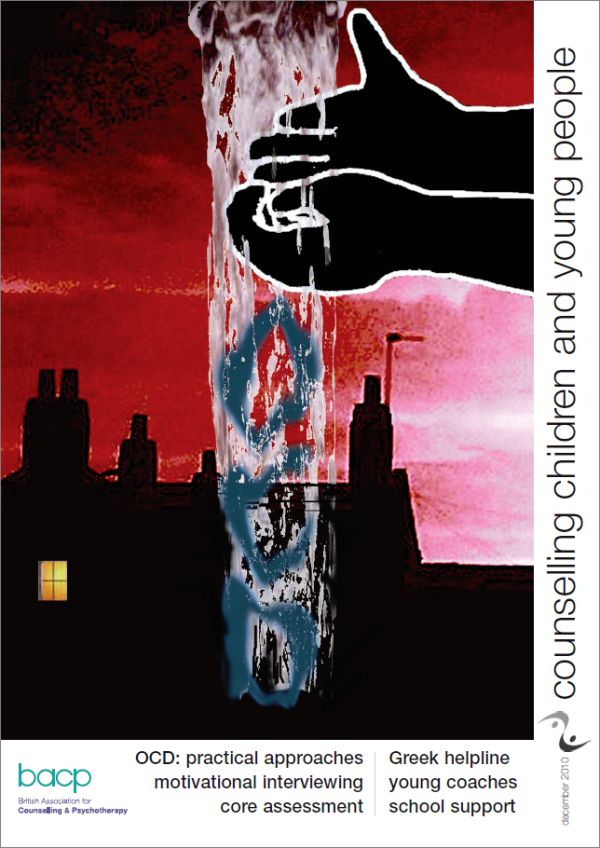In this issue
Working with OCD (free article)
Margot Levinson introduces paediatric obsessional compulsive disorder
First person: Claudia
Claudia Jacobs reviews the work she did on her OCD with her Human Givens counsellor Pamela Woodford
Bring on the family
Dennis Neill offers an example of a family approach to OCD
Using Emotional Freedom Techniques for OCD
Christine Moran demonstrates how to use an energy therapy commonly called ‘tapping’ to work on the anxieties underlying the compulsions
On assessment and other matters
Interview with Ruth Schmidt Neven, Director of the Centre for Child and Family Development in Melbourne
Motivational interviewing
Eddie McNamara and Cathy Atkinson explain how to engage the reluctant client
Supervision Talk 4
Julie Fallon writes about supervising work with so-called EBSD young people
From the horse’s mouth
Six personal opinions from Mike Shooter, immediate past Chair of YoungMinds
Destination PhD
Val Taylor is tracking her research into supervision for school-based counsellors
Index of CCYP 2007-2010
Therapeutic presence in schools
Sadegh Nashat and Mike Solomon explain two models of facilitating support and insight
Body-focused casework
Joanna Warwick found her client’s rheumatoid arthritis symptoms disappeared
Help for Greek adolescents
Eftychia Athanassiadou and colleagues review a new telephone service
Trauma-focused CBT
Jackie Feather outlines a step-by-step creative approach
Youth peer coaching
Young people make excellent coaches, reports Rachel Leigh
Executive committee
Introducing the current committee
From the chair and update

Not all articles from this issue are available online. Divisional members and subscribers can download the pdf from the BACP Children, Young People and Families archive.
Welcome from the editor
I found myself cogitating on the topic of assessment recently. You see, some parents had spent an hour giving me an intelligent, insightful report about their child during an initial phone call. And for a whole evening I actually believed it. Maybe it was the fabulous trifle I’d just eaten, or their knowledgeable vocabulary, or even my respect for the people who’d recommended them to me. Perhaps even my incompetence. But pretty soon, my writer’s instincts clicked in and I did a rethink. Let me explain why.
When you start writing a story for children, best practice is to start at a point called in media res – which means where the crisis or action is happening. Somewhere interesting. Something that grabs the reader. Now, that is the very point in real life at which parents phone up in desperation. Something has happened and become such an issue that they simply have to take notice. They then ring us for help. But what they tell us is not the whole story, only a snapshot in time: the immediate crisis, the why now? Running with that particular story would have been short-sighted of me and I’m glad I realised my error and quickly regained the sanity to think further. I was then able to backtrack as usual and find where it all started (as you would later on in a novel) and what else was going on in their wider family and environment, then and now. Only after this could we move forward wisely.
You see, if we don’t do this thoughtful questioning and listening before an intervention kicks in, we risk doing counselling that at best wastes everyone’s time and at worst drags the profession into disrepute. Both of which would be unethical and disrespectful to client and parents. So I was delighted to interview Ruth Schmidt Neven about her new book, and hear her views on the need for a thorough assessment before any therapy starts, as part of the therapeutic communication with the family. I hope some of what she says will resonate with all of us. For myself next time, well, I’ll just remember to leave the sherry out of the trifle if I’m going to speak with a parent!
One strange thing about being editor is that I commission the pieces for each issue separately, for all kinds of specific reasons, and then discover that the disparate authors mention similar ideas in passing. It’s as if, as a community, we have solid agreement about many aspects of our work – which is encouraging to see. We may yet reach accord on what constitutes essential training for working with young people. Most of you will not have the opportunity or privilege, as I do, of reading everything at least five times over, but I hope you will still enjoy the varied, thought-provoking or practical articles we have here, and let me know if there is a particular topic you would like to read about, or contribute to, in CCYP.
Finally, if it’s still before 24 December deadline when you read this, and you would like to be part of an initiative to get Developmental Trauma Disorder into the upcoming DSM V, please do visit www.traumacenter.org for details of how to fill in he anonymous survey. The request comes from Bessel van der Kolk and his colleagues, and, since young people’s therapists are in the thick of it dealing with trauma stemming from developmental deficits, it seems appropriate to mention it here. If DTD is to become a useful diagnosis, clinician data is needed from everywhere, not just America. It’s a historic opportunity, in that sense, and feels a bit in media res in the history of understanding children and their needs.
Eleanor Patrick
Editor
